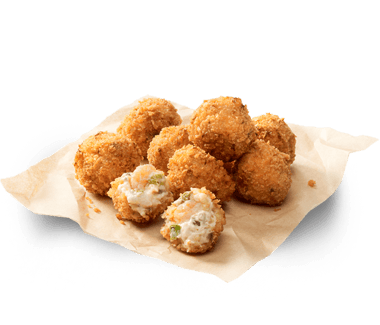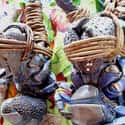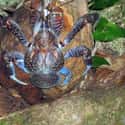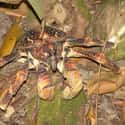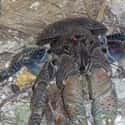-
(#8) People Catch Them And Eat Them
Of course, there are plenty of people crazy enough to catch a coconut crab, a feat that could easily cost them a finger if not done properly. By grabbing the two longest legs, just behind their two massive front claws, and pinning them together, it is possible to pick one up pretty easily. Or at least it looks easy. Sort of. Ok, not really.
Pacific islanders have been catching them for years and consider them to be a delicacy and an aphrodisiac. Apparently, coconut crabs taste very similar to lobster or regular crab meat. The fat in the abdomen and the eggs inside the female are considered the most delicious parts, and they can be prepared by steaming or boiling them, preferably in coconut milk.
Although the crab is not known to be poisonous, it is believed they can become toxic after eating certain plants for a long period of time. That said, they are generally not sold or eaten on a normal basis. In fact, eating a coconut crab on Christmas Island is a $5,500 fine.
-
(#10) They Could Become Endangered
Despite their curious appearance and behavior, not a great deal is known about the coconut crab or whether they are in danger of become extinct. While there's no doubt they are tough critters with an incredible ability to adapt, they may be vulnerable to the biggest predator of all - humans. Even though their overall habitat is relatively small, their total population has yet to be calculated by researchers, who have categorized them as "Data Deficient," meaning they are still trying to determine their population's status.
Some conservation efforts have implemented strategies to protect them from humans by limiting the number of crabs taken by hunters and enforcing a strict licensing process.
-
(#13) They Fall From Trees
One of the most curious things about the coconut crab is its ability to crack open coconuts through climbing trees. Once the husk is removed, the crab can grip the remaining nut in its claws and climb a tree up to 33 feet high, dropping it from the top so it will crack on the ground below. This makes it easier to access the nutty deliciousness inside without too much labor. Climbing down is not quite as easy, however, and they often choose to free fall if the drop is not more than about 15 feet.
For those who find the coconut crab to be somewhat alarming, this reality can cause a paralyzing fear of walking through a tropical coconut grove where these crabs are known to live.
-
(#7) They Can Grow To Be Enormous
Like others of their kind, coconut crabs begin their lives in the sea, floating freely and eating until they find the perfect shell to adopt. Once they establish their portable home, they can begin their transition to live on land. Although the shell is comfortable and safe, it soon becomes too small for the crab, and they are forced to venture out to find a new one with more room. After about a year of moving from shell to shell, the coconut crab must embrace its true nature of being the biggest, baddest arthropod in the world.
And like the Incredible Hulk, it breaks free from its restraints and emerges as a fiercer, stronger creature. The parts of its body that were once protected quickly harden through a process of recalcification, and the crab is free to become ginormous.
-
(#2) They Have A Lot Of Powerful Legs And Can Lift Up To 60 Pounds
Like all other crustaceans of its class, the body of a coconut crab is divided into different parts. The front section, called the cephalothorax, has 10 legs and an abdomen. The two front legs have powerful claws, followed by two pairs of strong walking legs with pointed tips. This combination allows them to adeptly climb vertical surfaces, including trees.
The fourth pair of smaller legs have tweezer-like claws for more precise actions like mating, tending to eggs, or making a nest. As for their large front claws, they are capable of lfting vegetation or rocks weighing up to 60 pounds.
-
(#9) They Are Grouchy
Coconut crabs do not enjoy visitors. They are known to burrow deep into the cool sand beneath the roots of trees as a way to hide from the sun, and will even avoid crabs of their own kind. They will aggressively defend their territory if challenged - especially if there's any food involved. When they emerge, their temperament is not much better, and they are largely keep their distance from one another.
To announce their presence, they will wave their large claws around in warning and scuttle around any other crabs they see. Decidedly unsocial creatures (unless it's mating season), coconut crabs live solitary lives - and like it just fine that way.
New Random Displays Display All By Ranking
About This Tool
As we all know, the coconut crab is the largest terrestrial arthropod and terrestrial crab. But you must not be fooled by its title. In fact, the natural habitat of coconut crabs is often in tropical woods not far from the sea, and the larvae produced by the breeding pair need to grow in the sea environment. Therefore, the Western Pacific and the entire Indian Ocean are their most common places of residence.
The coconut crabs are huge and anti-social, they will steal your silverware and can tear the whole coconut with their claws. It is a great time to know more about this shocking animal, the random tool introduced 13 facts about the coconut crab that many people do not know.
Our data comes from Ranker, If you want to participate in the ranking of items displayed on this page, please click here.

